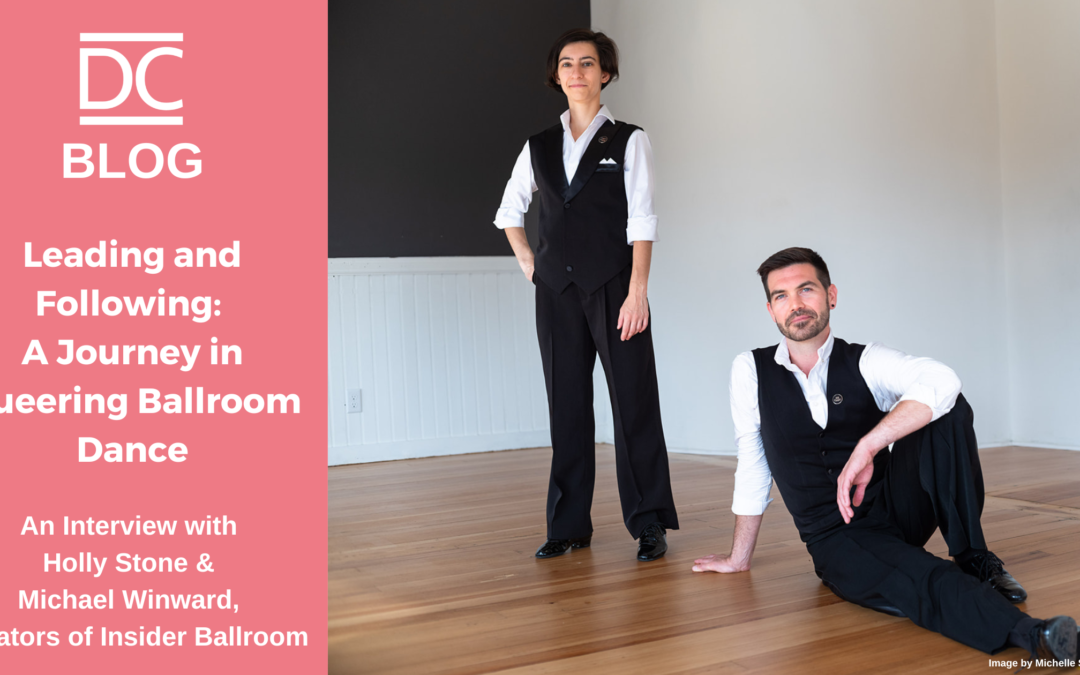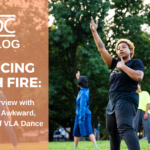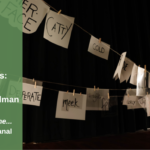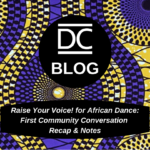Amidst the open windows along Mass Ave, vibrant energy enveloped The Dance Complex’s Studio 7, where smiling faces flowed in like a lively stream. As I observed the dynamic scene, my curiosity lingered on the intriguing dialogues unfolding between both new and familiar couples. After the initial lesson facing the mirror, the social dancing began in which the atmosphere was one of consent, encapsulated by the simple yet powerful question, “Would you like to dance?” It became evident that a shared understanding and appreciation for the art of this dance permeated the space. When engaging with those who seemed to exhibit proficiency, I took the opportunity to seek insight through questions or following their lead, navigating the nuances of body language and spoken words. Partnerships unfolded in various forms—some arrived and stayed hand in hand, while others explored connections beyond their usual companions. Personally navigating the event solo, my journey unfolded in the ever-evolving tapestry of social gatherings. From the initial mirror-facing lessons to the immersive experience of partner dancing, the studio transformed into a haven of guidance, laughter, and the delightful exchange of dance partners. The diversity in footwear—boots, sandals, heels, and sneakers—mirrored the eclectic mix of individuals converging to celebrate the inclusive realm of Gender Expansive Ballroom dancing. Read on to learn more about Holly Stone and Michael Winward, facilitators of the social and Insider Ballroom collaborators, and their journey in queering Ballroom dance.
CJ Donohoe: How did each of you find ballroom dance?
Holly Stone: I first started doing ballroom when I was 17. I had been an intense pre-professional ballet student up until that point and was not so gently told that I was not going to be a professional ballet dancer so I started looking for other outlets. When I went to college, I caught the bug. I started going out to social salsa clubs when I was 18 and that changed my life. I started as a social salsa dancer and through that, I got connected to the college team at Syracuse University, where I attended school, and started dancing with them.
Then I very quickly found a competitive partner in what’s called International Standard style, which is waltz, tango, foxtrot, quickstep, Viennese waltz of a particular flavor. I got a partner who was well-matched height-wise and who already knew a bunch, which is pretty rare. We hit it off and we started competing together.
I was sort of straddling these two worlds for a long time. I was doing the social dance thing, and then I was also doing the competitive thing for five or six years. One thing led to another and here we are!
Michael Winward: I got a B.A. in Dance and Drama, and loved making spoken-word contemporary dance pieces. By the time I was 25, I realized that there wasn’t much of a market for the thing I like to do. So I answered an ad that said, “Sleep till Noon and Dance the Night Away”. I saw it on the Boston Dance Alliance website. I interviewed at a studio and realized I had never been in a world like this. I’d done contemporary dancing and I danced at Lowell High School because you could take dance instead of gym class. It was a great program but it focused on contemporary, modern dance, and a little bit of ballet training, but never partnering in that technical framework. I came from a dance background that was more modern, contemporary, ballet dance; the partnering aspect and how mechanically two people work together to move efficiently together–that felt new in my body.
CD: Could you speak more about the cultural differences between social and studio dance?
HS: The thing that is different between the two of us is that I came to Ballroom as an amateur before I started working in the professional world, whereas Michael jumped straight into the professional world with no Ballroom experience–which is a common experience for people in the industry. The industry tends to hire people who don’t have any idea what’s happening- that’s perhaps a different point. When I first started working in the professional world, I started in Florida and worked at Fred Astaire for a couple of years before ending up in the Boston area working for Arthur Murray, which is the other big legacy franchise system.
Between the social dance world and the studio, they’re intertwined yet distinct. The studio system, broadly speaking, markets to, I would say, three different groups of people. You’ve got your wedding couples, people who are looking to learn how to dance for some kind of special occasion, which usually has a short, demarcated timespan. There are retirees who are looking for an activity to do together, and then what I like to call the divorcées–people who have had some kind of tumultuous upheaval in their life and are looking for community and a way to be active at the same time.
The oeuvre of this glamorous, fantasy-tinged, idea of dancing with young attractive people, appeals in one way or another to all of those groups of people as does the general knowledge that there will be a collective of people that you’ll meet outside of just the instructors.
MW: I’ll highlight that every instance of those three groups of people Holly described are all based on romantic partnerships, but then what ballroom dancing can become to them is something very, very different. When we think about the nuts and bolts of this form itself, it is essentially all based on various agreements and essentially a consent practice.
Like we do this gesture [Michael extends their hand out, palm up] on stage and invite the audience, if they want to, to do this with us. We talk about the hands gently coming together and there’s a way of doing it in a way that could feel right and in a way that could feel wrong. There’s all this potential for transferable skills and for life benefits like gaining balance, control, rhythm, and coordination, and those so easily can become selling points. These skills came from different social practices and weren’t born with the idea that they would be commodified in this way. Our question becomes, how do you hold on to the benefits towards finding a way of disseminating the practice differently from the studio systems, with the idea of hopefully finding, in this case, a queer other?
One of the fundamental skills, which is leading and following, is going to be referred to as such and not be gendered. It seems so elemental, I think, if you’re queer and doing it, but the entire culture that we’re talking about can feel so far away.
Even though very recently the rule books are changing to try to keep up with the times, Holly and I watched that history unfold, simultaneously feeling what it’s like in the studio on a day-to-day basis, how labor practices come into play, and fully being oneself in spaces like this that are so inherently heteronormative –it’s just fascinating.
CD: I noticed last night that that space was a consent-forward gender-neutral environment, without having to spell it out using those words, which might turn people away. There’s definitely a care in both of your practices in bringing this work to a variety of different demographics and communities. Why is it important for you to share social dance with a variety of different communities?
HS: For myself, I was in the franchise world much more recently than Michael, and I had to figure out how to produce the environment that I wanted without using leftist jargon, for lack of a better term, because I knew it would turn people off if I used that sort of language.
I know that the things that I’ve learned from the partnership and communities that I’ve danced in has made me who I am and made me a better person and I want to be able to offer that to other people. I particularly like teaching university students, partly because I get to have a little bit more of an intellectual engagement about the thing that we’re doing in addition to doing it.
CD: I loved the historical context moments you did do during the workshop. It was a natural break as well in between moving, sprinkling in some history.
MW: The day job that I have is ballroom dancing in assisted living and dementia care, elder and mind care communities. The thing that feels interesting to me about that is it’s a way to take the skill set and be able to partner in various dance styles, in a completely different setting from the studio where I learned it. It’s not a beautiful condition, dementia, but there are a lot of beautiful possibilities that I’ve found in taking it into dementia care. Specifically, it’s a clinical care space, so there’s a real importance to being able to find balance with a partner, who might normally use an assistive walking device, for example. I’m not in any way a therapist and I’m not doing the clinical practice myself. This is just what the skills of partnering and partner dancing are, and it’s a different possibility than what I could have imagined going into the whole thing.
In showing up in these spaces, I end up queering these spaces–it becomes a kind of negotiation, it’s another kind of labor with all of the implications of doing it in that particular setting. I find it fascinating, interesting, and rewarding. I’m connecting with a lot of people. I’m sweating and laughing, there’s a lot of benefits, but again, there’s no responsibility to be the therapist, even if there are therapeutic benefits. There’s no responsibility to teach, although co-learning certainly happens. I get information from every dance partner of the hundreds at this point. There’s a potential for a rethinking of hierarchy in relationship to this dance form in this new-to-me environment.
CD: In this trajectory of queering the ballroom dance scene language, I’m interested in when you started to notice the gender-expansive possibilities of social dance, or if it was innate.
HS: The written rules about who gets to dance with whom at events were changed in 2019, so pretty recently. There’s a difference between something being changed on paper and the culture adjusting. I found since being in the mainstream industry from 2017 to 2023 that it depends on where you are, who you’re around, and what the comfort level is with partnerships outside of traditional cis heteronormativity.
My read on it right now, at least in the Arthur Murray world, is very much lip service. People want to be able to say we welcome everybody but there’s not actually any movement or action or initiatives to actively welcome people in, aside from just saying it. I spent three years trying to explain and understand how to shift things in that world before essentially giving up and leaving.
The fact that we only publicized this event a week and a half before, and it filled up quickly, shows me that there is a market for this. I’ve been in other spaces, especially the studio that I used to work at, where nontraditional partnerships would happen, but it would always be a thing that would draw everybody’s attention, and everyone would stop and look at it and be like, “ooh, it’s different”, there is some validation that comes with the attention of that, but there’s also some stress with suddenly being the center of attention. The thing that made me happiest about the workshop was that didn’t matter, nobody blinked. Observing that made me realize what I’ve been missing this whole time. This is what it actually feels like and looks like to be able to say, everybody is welcome to dance. And even if you only danced in a way that would be accepted in the mainstream industry, it didn’t matter. It’s fine to make that choice, but that’s not being elevated above other options.
MW: That was powerful for me, too. One of the things that felt powerful to me was that the workshop was free. That’s resistance to the status quo of how it often pans out, and, inherent in that is a collaboration between the two of us, the Dance Complex, the site of the event, and then NEFA [New England Foundation for the Arts], the funder on board. We’re expanding the conversation and making it financially accessible, something that has historically been a part of the queer ballroom dance scene–removing that barrier to access.
I worked for Fred Astaire Dance Studios from 2009 until 2016, just before the rule change, and that sentiment of “we tried to make a change before we quit” feels relevant to both of us.
I found a dance partner, Kalin Mitov, who I would compete with, at events sanctioned by the North American Same-Sex Partner Dance Association, an organizing body that provides competitions and spaces. We would go and compete and then we would street perform in Provincetown and put out a hat and try to raise money to compete ourselves because we’d have to get a plane ticket. There are histories here, beginning longer ago in Europe, specifically these queer-friendly partner ballroom dancing spaces.
Seeing that alternative at the time when I was working for a franchise, I felt a distinct difference. In a workplace, there’s an amount of energy and labor I have to expend to be working in this world, as opposed to it being my social activity that I go and do for fun. The politics of that feels very real.
Whether or not one can show up in a space and feel fully oneself, to me it’s a no-brainer. Being able to follow becomes part of my expression. Queering this activity is also to not need to involve romance.
It would be strange for me, especially as a professional in this space, to dance with somebody who I’m also sexually attracted to, whereas that could be presumed about everyone else in the space around me, there’s a dichotomy in that and that it’s strange and weird–and having to articulate it is doing yet more labor.
There’s this weird thing about “doing” the products that we’re selling, and there being lip service within that institution, as Holly was saying. There’s a difference in how something is articulated and how it’s lived in space and embodied.
HS: For us, there’s a resistance to transactionality. Literally in the sense of the financial barrier to this practice. But also, being a dancer or being a dance partner becomes commodified in certain ways. My little tagline that I tell people when they ask, ‘what’s it like to be a professional ballroom dancer?’ Well, it’s one-third personal trainer, one-third couples therapist, and one-third escort! All of which are interpersonal, but mediated by transactions.
CD: How did you two begin working together?
MW: We’re thinking about a practice that hopefully can grow in different directions. We get to share what we’re doing in other places and to honor that, so much of this becomes regional-specific. When we talk about how to shift the dance ecology of where we are, I’d be remiss not to mention karen krolak of Monkeyhouse dance. An individual who is running a very small grassroots arts organization is building these connections. The Dance Complex, being a relatively larger organization, has a significant impact on the dance ecology. It’s crucial to recognize that this influence extends to the evolution of systems and the individuals managing smaller entities. It’s important for us, whether operating on a small scale or within diverse systems, to prioritize considering less oppressive methods of creating art and actively fostering inclusivity in spaces, thinking administratively about how these ideas are to materialize.
HS: In the winter of 2022, both Michael and I independently, were working on solo material about our experiences in the ballroom world. karen happened to see both of them and thought we should know each other. We chatted on Zoom for two hours and decided we should probably meet. We got in the studio, danced around, thought, oh, this is fun, and it evolved from there. We started working on the show that we have right now more seriously back in March 2023.
MW: Insider Ballroom, which is the name of what we do together, started as part of the Regional Dance Development Initiative. That began with me working collaboratively with a team of people, Catherine Siller, Betsy Goldman, and EJ Joseph. They directed me as a soloist about my experiences with Ballroom dancing. During that process, in meeting Holly it became evident through working together and gradually developing routines (you can’t do the ballroom routines that we do without two people), everything about the evolution of this work means needing a dance partner.
This work is happening gradually. We started with one two-minute routine that we could perform by itself at different events. That expanded to doing all the dances of the competitive category and choreographing a lead switch. That feels important. Then we have the context of this show, which is a framework for different dances to take place within it, surrounded by storytelling and how to articulate our experience.
I want to acknowledge all the people in the organizations that made this happen and also what we now have arrived at–this phase of work that hopefully is going to grow. I appreciate Holly and being able to do these things with intention feels rare and exciting, and hopefully manifests in all these various ways.
CD: Anything you want to shout out that’s on the horizon for you two or add to this conversation?
HS: We’ve got a handful of things. We’re running a dance party at Williams College in February as part of their Queer Perspectives Festival. We’re probably going to College of the Atlantic in Maine in April to do the show and some teaching. At the Dance Complex on June 21st, 22nd, and 23rd, there will be several performances of the show, some workshops, and social dance activities in concert with that. We haven’t talked about this, but I would really like the Gender Expansive Ballroom Social that happened to be a monthly thing. We just have to figure out a way to make that happen that feels like it fits into what we’re doing. And then we’ll see where it goes from there!
MW: Broadly speaking, the idea of combining the performance with an intentional teaching moment with intentionally not teaching, there’s a lot of power in dancing socially, no one’s teaching anyone, we’re doing it for fun, nobody’s looking at it as a performance. The convergence of those three things feels exciting and powerful and part of what the future holds.
HS: The Ballroom world has a weird relationship with virtuosity or technical excellence in the sense that it’s very heavily behind a paywall. The deeper into it you get, the steeper the paywall gets. So that means that technical information only really flows in one specific direction. I’m curious about two different ways of dealing with that. One, as a sort of outcast from the mainstream Ballroom world, I have a lot of technical expertise from having done it for 15 years and would love to find ways to be able to share that with other people in the queer/same-sex Ballroom world, especially because of the inaccessible price point. Two, as Michael was getting at, not needing that high level of technical expertise in order to have fun. At the event the other night, we gave everybody the bare minimum amount of information that they needed to get moving. And a lot of folks already had dance experience so we can’t claim responsibility for everything that happened, but it’s about getting everybody rolling. Then if they want more, there are other resources to point them to.
For me, I don’t know if I’m completely ready to let go of all of that technique at this point, partly because I’ve spent so many years working on it by myself. I’m also interested in trying to figure out other ways of using it. Dancing with Michael is one of them because that’s what we do, but then, how to share that with other people who also might want it.
MW: Especially doing this in eldercare for so long where I’ve been away from anything that’s going to teach me how to get technically better, it’s more a matter of feeling what it means for me to embody this thing. I’m better because of all the dance partners that I’ve had over the past seven years working exclusively in eldercare. I’ve gotten technically better because I’ve had to ground myself for a very logistically important reason, we’re not going down, either of us right now. We’re definitely interested in growing in relationship to the existing model that’s othered from what its essence is.
Keep up with Holly and Michael to stay up to date on events, workshops, performances, and more social gatherings.





